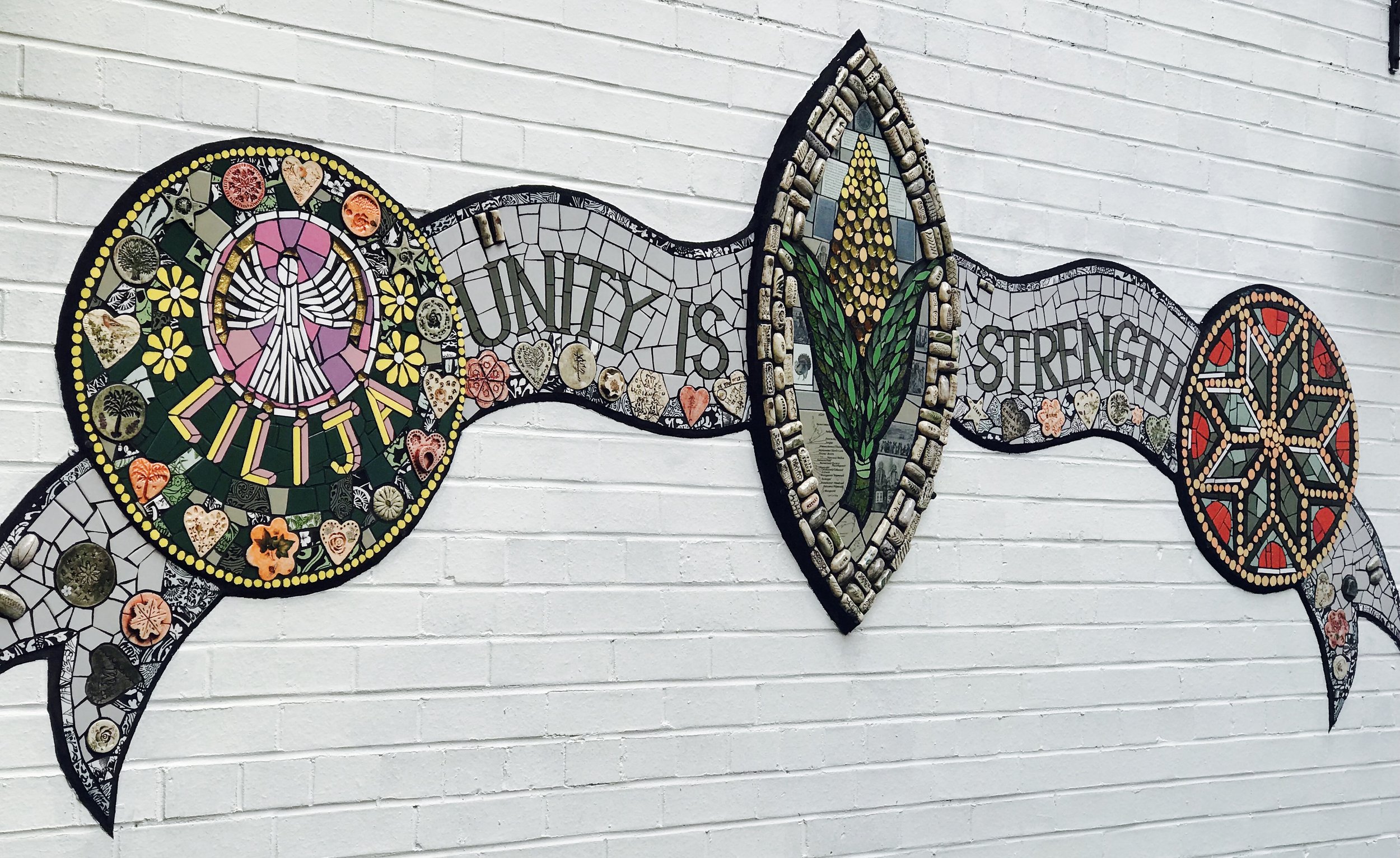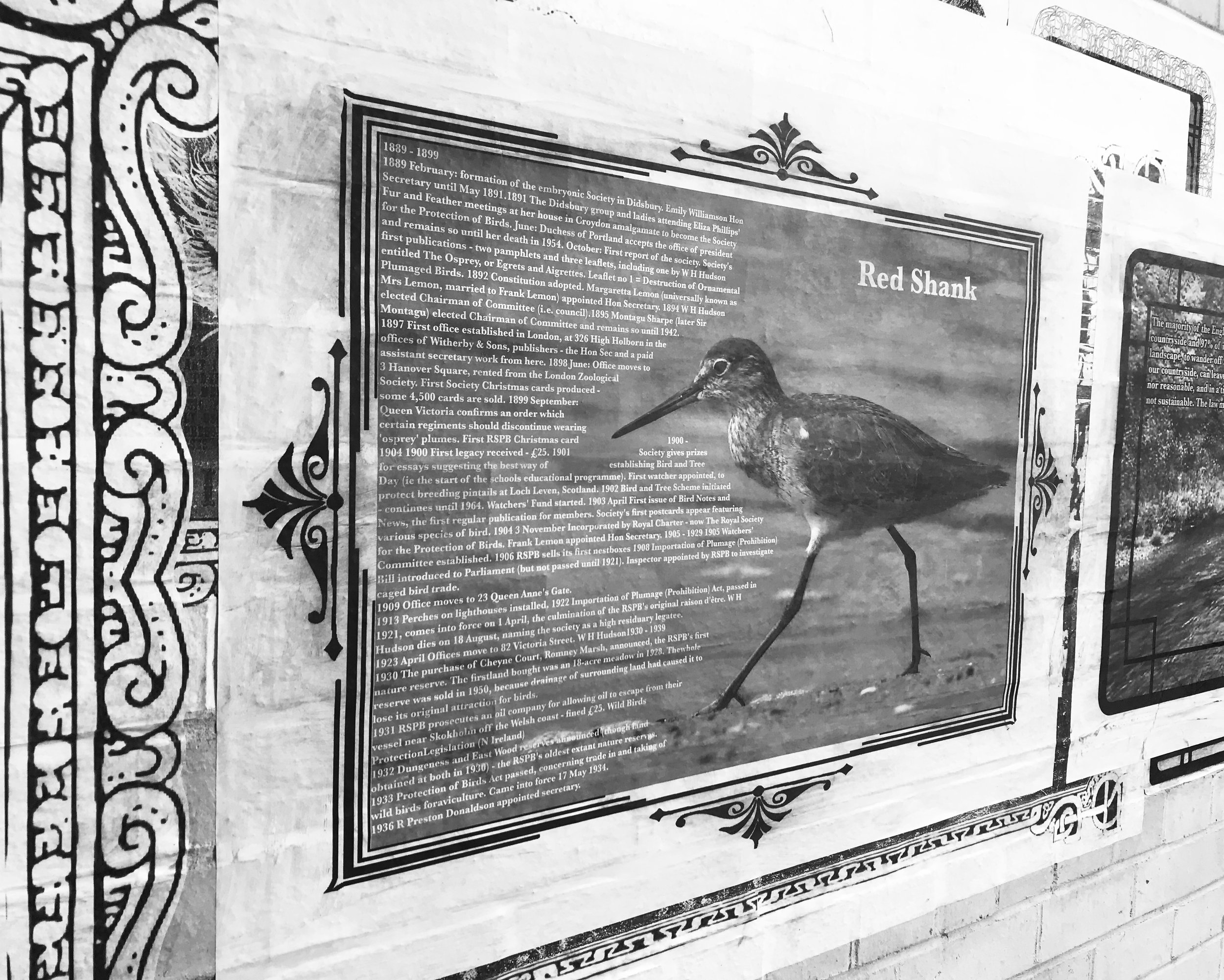Public Art
At the heart of Karen's Public Art is collaboration.
In public spaces, the mark of the individual, of highly crafted artworks, humanises and counters the increasing use of advertising.
Dolphin Lane
BOSTON
This Heritage Public Art Project comprised of an exploration of the natural environment surrounding Boston, and how it has changed over the centuries, detailing the draining and flooding schemes. Using the archives to detail these changes, from the writings of Joseph Banks to local farm workers, from ornithologists to botanists, we developed a narrative which took the form of large posters pasted up in the streets, full of facts and figures to promote discussion during consultation.
In the final artworks, a ceramic tapestry detailing the unique flora and fauna, as well as historical images and texts was created through the use of ceramic decals printed onto tiles, to make a permanent and accessible archive, to be explored by audiences, and used as an educational tool in an ongoing way.
The two sets of ‘medieval stained-glass windows’ were created on 2 walls of the courtyard in Dolphin Lane, within a medieval lane which once led out to the open fields.
The richly ornate frames of the windows were constructed with handmade tiles by hundreds of local people, which were built into a decorative mosaic.
The environmental history windows pair with windows detailing the social history, the subjective histories, and the social groups that advocate and support our communities. These narratives, of course, intertwine, with fishing families going back 4 generations, the old public houses and inns used by traders, intergenerational farm workers and so on.
The fenlands and Frampton Marsh were explored, the creation of the nature reserve, as well as the enclosures and huge changes in farming practices over the centuries. This inevitably highlighted the plummeting diversity and abundance, with the rise in industrial farming. The success of the RSPB reserve and the vast numbers of birds protected is celebrated. We looked at the origins of the RSPB in Manchester, initially as a resistance to the trend for birds’ feathers in the Victorian era.
The artworks include over 400 ‘panes of glass’ in the windows.
Social media platforms were useful for historical research, promotion and inclusion, confirming Audience as Participant on many levels.
By also creating a garden within the courtyard, it was our intention to speak of the importance of place-making, of communal participation and ownership of public space.
Through growing food we explored diverse experiences of wild food, herbs and cuisine from both local, and newer communities of Europeans from largely rural backgrounds. This aspect also increased engagement and allowed for important cross-cultural work, with often marginalised groups.
The Elm Tree of Life
FINSBURY PARK STATION
The Elm Tree of Life, Finsbury Park Station, is a social and environmental statement. The content for this work developed from a year of consultation and workshops within the community.
Here, we explored and considered ordinary lives, chronicling individual testaments, as well as opening local archives.
Basic human need is highlighted alongside the need for meaningful culture; through music, sport, literature and spirituality.
By bringing together marginalised groups and meeting with those who do the important work of supporting and advocating, we aim to raise the level of empathy in public space. Included in this rich tapestry are braille ceramics, groups artworks and handmade ceramic stars.
The act of making and expressing is healing. This work is at once a celebration of our lives and history, what’s important to us, and a memorial to what is being lost. It is also a resistance to the well established canon of a public art that is abstract and elite.
The central feature of the mosaic is an Elm Tree, selected due to a long tradition, dating back as far as 1350 when seven sisters (hence the name Seven Sisters) planted an circle of elms with a hornbeam at the centre.
The elm tree was chosen as a symbol because seven sisters planted a circle of elms in Finsbury Park in the 1500s and this ritual has been repeated over the centuries.
60 million trees have been lost to Dutch Elm disease in the UK. Most now live in hedgerows and don’t reach maturity. The oldest populations are in Brighton and Buxton.
Our tree shows the names of some of the hundreds of species that rely on an Elm, the invertebrates, birds, lichens and mosses that create the ecosystem that is a mature tree. It's about the importance of biodiversity and richness in our environment, to maintain health for all.
Known for its beauty, the Elm is also important in folklore, being associated with the underworld.
Amongst its many uses, Elm sustains well in water and was used for boat building, bridge foundations and cartwheels. Hollowed out Elm was used to make water pipes and sinks before the use of metal.
Karen is currently finding a suitable site for the planting of a new circle of disease resistant elms- the first since 1996, to continue this important tradition. We are currently seeking seven sisters to plant the trees.
Made with Carrie Reichardt and ATM Streetart. READ MORE
'We are all immigrants' designed and made by the Womens Therapy Centre, the Maya Project and Phoenix Haringey Community Centre. Printed onto tiles in the main geometric sections.
'Dare to be free' designed and made by the Womens Therapy Centre, the Maya Project and Phoenix Haringey Community Centre Printed onto tiles in the main geometric sections.
The intricate border of textile patterns, with handmade ceramic stars made in community workshops in the N4 Library and Redmond Community Centre
Celtic birds refer to the strong Irish legacy of this area and serve as 'gargoyles' at the top of the artwork to protect from harmful spirits
Printed details of the rich musical legacy of Finsbury Park, from the George Robey to the Rainbow, and the ANC's roots here.
The Tree of Life
SOUTH ACTON
An ecological and social history ceramic mural.
Acton Gardens Public Art Commission, including mentoring and public consultation and workshops.
The huge oak forests that covered this area until the city's expansion are celebrated and represented by a large black and white mosaiced oak tree. Our reliance on the natural world is depicted amidst the rich social and cultural heritage of this area.
Made with Carrie Reichardt and ATM Streetart
Hope Gardens
Mural for emergency housing, made with a local homeless charity and new residents.
The habitat of a kestrel is depicted, a rich meadow that offers shelter and food to a wide variety of animals, insects and birds. Here, we are drawing attention to the loss of affordable housing, alongside the environmental crisis in our cities and beyond.
Made with ATM Streetart
Home
RECREATION GROUND, WEST LONDON
Oversized settee and footstool made as part of a Heritage Project exploring notions of home in this richly multicultural area with the Armenian, Somalian, Afghan, Caribbean and Iranian communities. We worked with schools, community centres, youth and lunch clubs, libraries and museums.
Made with Eoghan Ebrill
Bread and Roses
CENTRE FOR CONTEMPORARY ART AND THE NATURAL WORLD
SOIL CULTURE ARTIST’S RESIDENCY, UN INTERNATIONAL YEAR OF SOILS
Karen's residency was at Hannah’s, Seale Hayne, a large charity for children and adults with Learning Difficulties. Set in 70 acres with a grand building and artists studios, radio station, recording studios, gardens and animal farm and sports centre, this therapeutic community provided a wonderful site for Karen's sculpture which was adjacent to the community hall, and leading out to a newly planted hillside.
Karen was given access to the archive of this Agricultural college c1919, that was home to many of the Land Girls images and an important hospital for the rehabilitation of WW1 war veterans from 'shell shock' (PTSD) under the radical doctor Arthur Hurst.
The structure of the sculpture was made from hazel and the seat made from Cobb, a mix of clay, sand and straw dug from the site to ensure we are in touch with the soil as we sit and read about the rich heritage of this place, or look out over the estate.
All components were made with residents according to their interests and skills; The roof tiles were hand made and fired in the ceramic studios, sweet chestnut shingles were split and covered the upper part of the roof
The mosaics were made on site with residents, also at The Respect Festival and The Bovey Tracey Craft Fair by the public
'Affective Landscapes' went on a Touring show, to The Eden Project, Create Centre, Bristol, Falmouth Art Gallery, Kew Gardens, Schumacher, Falmouth University RANE (Research in Art, Nature, and the Environment), Hauser and Wirth amongst others.
Habitat
HAYWARDS HEATH
Wheat
Museums and Galleries
Treatment Rooms
MOSAIC HOUSE
EALING, LONDON
Karen has worked as part of the Treatment Rooms since its inception, working on a large range of projects including the HQ Mosaic House.
Made over 20 years, it reflects different periods, as outlined in this article.
Disobedient Objects Exhibition
VICTORIA and ALBERT MUSEUM, LONDON
Showing creative dissent from around the world. Two mosaic panels for the entrance to the museum and texts installed on the risings of the steps.
With the Treatment Rooms Collective
Thelma Hulbert
THELMA HULBERT GALLERY, DEVON
Celebrating the life of the artist, Thelma Hulbert in this permanent furniture central to the herb garden and Gallery.
Mosaic Screen and Water Fountain
VICTORIA and ALBERT MUSEUM, LONDON
Made with the Arabic Family Centre for the Jameel Gallery.
Nurture and Learning
COGGES AGRICULTURAL MUSEUM, OXFORDSHIRE
Resident artist for Family Learning over two years.
Introducing groups to the aesthetics of food growing and outdoor cooking. 'Nurture and Learning' was a programme for families with adopted children addressing attachment difficulties as a barrier to learning.
Gardens were made, bird boxes and insect houses, earth ovens and soup and bread cooked on open fires.






















































